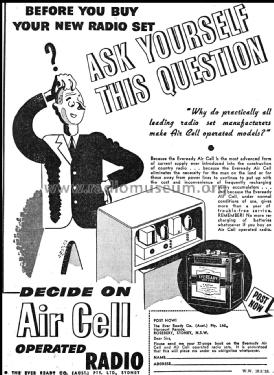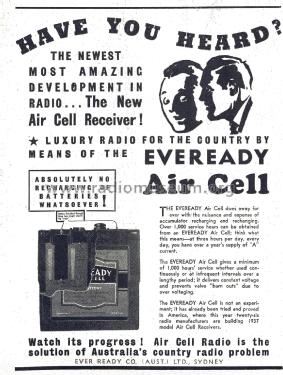Eveready Air-Cell S2600
Ever-Ready/Eveready (Brand in Australia - 1901 - 1985); Sydney
- Paese
- Australia
- Produttore / Marca
- Ever-Ready/Eveready (Brand in Australia - 1901 - 1985); Sydney
- Anno
- 1936
- Categoria
- Alimentatore/stabilizzatore di alimentazione o batteria o caricabatterie
- Radiomuseum.org ID
- 313038
- Tensioni di funzionamento
- 2 Volt
- Materiali
- Speciale materiale, descritti nelle note.
- Radiomuseum.org
- Modello: Eveready Air-Cell S2600 - Ever-Ready/Eveready Brand in
- Dimensioni (LxAxP)
- 6.5 x 10.5 x 10 inch / 165 x 267 x 254 mm
- Annotazioni
-
Eveready Air-Cell.
2 Volt, long life, “A” Battery
The Air-Cell battery was widely used in the outback of Australia as a 2 Volt radio “A” filament source in areas were battery charging was inconvenient or expensive. The radio using the battery had to be designed with a suitable dropping resistor to limit the current to the filaments due to the voltage decline over the life of the battery. The battery gave 1000 hours of service as long as the load current was below 0.65A.
Construction and Implementation
This type of battery is made up of two cells assembled in a one-piece moulded container. The external appearance is not unlike that of a six-volt accumulator. The two cells are internally connected in series so that only two terminals are provided for connection purposes.
This type of battery uses a sodium hydroxide (caustic soda) solution as its electrolyte and is not refillable; the electrodes being so proportioned that they disintegrate at about the same rate as the electrolyte weakens.
The "AirCell" is shipped dry and in a sealed condition. The active material of the electrolyte is contained in the cells and as long as the seals are not broken, the battery will stand indefinitely without deterioration. An advantage of this system is that the user only needs to break the seals and fill the cells with water (ordinary drinking) when he wishes to place the "Air-Cell" in operation. The battery is ready for use about fifteen minutes after filling with water.
Voltage Variation
The terminal voltage of an "Air-Cell" battery immediately after activation is approximately 2.53 Volts. After twelve to fifteen hours use at maximum load (0.65 ampere), this voltage drops to about 2.45 Volts. This voltage is held constant for an appreciable length of time, whether the battery is used continuously or intermittently, and then commences to drop gradually till it reaches 2.25 Volts at the end of 1000 hours of service. At this point, the voltage drops off rapidly and the cell becomes completely exhausted. It should be noted that the terminal voltages given above are totally independent of the load imposed on the "Air-Cell" (as long as the load is kept below the rated maximum of 0.65 ampere).
"Air-Cell" Application
On account of the small variation between the activation and exhaustion voltages of the "Air-Cell" it has been found possible to use a resistor of fixed value for voltage dropping purposes instead of a variable rheostat. This simplifies matters considerably as it means that the resistor can be built into a receiver designed for "Air-Cell" operation and no adjustment is necessary at any time, even when a new "Air-Cell" is connected to the receiver. To proportion this resistor, it is necessary to take into account both the permissible filament voltage variations and the filament current of the valves used in the receiver.
- Prezzo nel primo anno
- 2.43 AUS £
- Bibliografia
- Radio Trade Annual of Australia (1937, page 236 & 239)
- Letteratura / Schemi (1)
- - - Manufacturers Literature (Eveready Trade List No. 23, May 1942.)
- Autore
- Modello inviato da Gary Cowans. Utilizzare "Proponi modifica" per inviare ulteriori dati.
- Altri modelli
-
In questo link sono elencati 41 modelli, di cui 31 con immagini e 1 con schemi.
Elenco delle radio e altri apparecchi della Ever-Ready/Eveready (Brand in Australia - 1901 - 1985); Sydney


